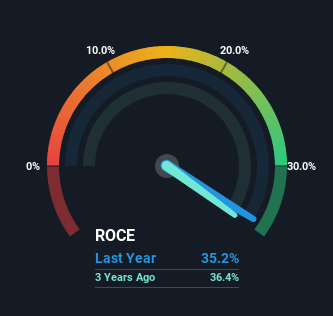If we want to find a potential multi-bagger, often there are underlying trends that can provide clues. Ideally, a business will show two trends; firstly a growing return on capital employed (ROCE) and secondly, an increasing amount of capital employed. If you see this, it typically means it's a company with a great business model and plenty of profitable reinvestment opportunities. That's why when we briefly looked at HomeMaid's (NGM:HOME B) ROCE trend, we were very happy with what we saw.
We've discovered 2 warning signs about HomeMaid. View them for free.Understanding Return On Capital Employed (ROCE)
Just to clarify if you're unsure, ROCE is a metric for evaluating how much pre-tax income (in percentage terms) a company earns on the capital invested in its business. The formula for this calculation on HomeMaid is:
Return on Capital Employed = Earnings Before Interest and Tax (EBIT) ÷ (Total Assets - Current Liabilities)
0.35 = kr36m ÷ (kr247m - kr144m) (Based on the trailing twelve months to December 2024).
Thus, HomeMaid has an ROCE of 35%. That's a fantastic return and not only that, it outpaces the average of 9.9% earned by companies in a similar industry.
See our latest analysis for HomeMaid

Historical performance is a great place to start when researching a stock so above you can see the gauge for HomeMaid's ROCE against it's prior returns. If you want to delve into the historical earnings , check out these free graphs detailing revenue and cash flow performance of HomeMaid.
The Trend Of ROCE
It's hard not to be impressed by HomeMaid's returns on capital. Over the past five years, ROCE has remained relatively flat at around 35% and the business has deployed 423% more capital into its operations. With returns that high, it's great that the business can continually reinvest its money at such appealing rates of return. If HomeMaid can keep this up, we'd be very optimistic about its future.
One more thing to note, even though ROCE has remained relatively flat over the last five years, the reduction in current liabilities to 58% of total assets, is good to see from a business owner's perspective. Effectively suppliers now fund less of the business, which can lower some elements of risk. We'd like to see this trend continue though because as it stands today, thats still a pretty high level.
Our Take On HomeMaid's ROCE
In summary, we're delighted to see that HomeMaid has been compounding returns by reinvesting at consistently high rates of return, as these are common traits of a multi-bagger. On top of that, the stock has rewarded shareholders with a remarkable 640% return to those who've held over the last five years. So while the positive underlying trends may be accounted for by investors, we still think this stock is worth looking into further.
If you want to continue researching HomeMaid, you might be interested to know about the 2 warning signs that our analysis has discovered.
High returns are a key ingredient to strong performance, so check out our free list ofstocks earning high returns on equity with solid balance sheets.
Valuation is complex, but we're here to simplify it.
Discover if HomeMaid might be undervalued or overvalued with our detailed analysis, featuring fair value estimates, potential risks, dividends, insider trades, and its financial condition.
Access Free AnalysisHave feedback on this article? Concerned about the content? Get in touch with us directly. Alternatively, email editorial-team (at) simplywallst.com.
This article by Simply Wall St is general in nature. We provide commentary based on historical data and analyst forecasts only using an unbiased methodology and our articles are not intended to be financial advice. It does not constitute a recommendation to buy or sell any stock, and does not take account of your objectives, or your financial situation. We aim to bring you long-term focused analysis driven by fundamental data. Note that our analysis may not factor in the latest price-sensitive company announcements or qualitative material. Simply Wall St has no position in any stocks mentioned.
About NGM:HOME B
Outstanding track record with excellent balance sheet and pays a dividend.
Market Insights
Community Narratives




